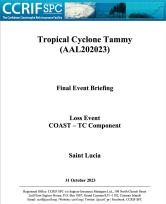 Final Event Briefing - TC Tammy - Loss Event - COAST - TC Component - October 31, 2023
Final Event Briefing - TC Tammy - Loss Event - COAST - TC Component - October 31, 2023 |
This event briefing is designed to review the modelled losses due to wind and storm surge due to Tammy, calculated by the TC component of CCRIF’s fisheries model for Saint Lucia, to be analyzed with respect to its COAST policy. Saint Lucia was the only CCRIF member country for which the CCRIF fisheries loss model for wind and storm surge (i.e. the TC component) produced government losses due to Tropical Cyclone Tammy. |
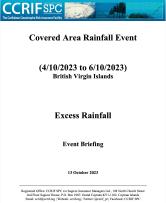 Event Briefing - Excess Rainfall - Covered Area Rainfall Event - British Virgin Islands - October 13, 2023
Event Briefing - Excess Rainfall - Covered Area Rainfall Event - British Virgin Islands - October 13, 2023 |
This event briefing describes the impact of rainfall in the British Virgin Islands, which was associated with a Covered Area Rainfall Event (CARE), starting on 4 October and ending on 6 October 2023. |
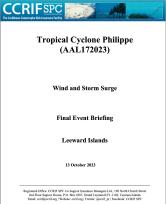 Final Event Briefing - TC Philippe - Wind and Storm Surge - Leeward Islands - October 13, 2023
Final Event Briefing - TC Philippe - Wind and Storm Surge - Leeward Islands - October 13, 2023 |
The final runs of the CCRIF tropical cyclone loss model for wind and storm surge produced government losses for Antigua and Barbuda, Saint Kitts and Nevis, Sint Maarten , and Anguilla. However, the government losses for all four countries were below the Attachment Point of the respective countries’ Tropical Cyclone policy. Therefore, no payout under these policies are due. |
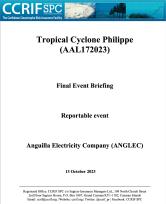 Final Event Briefing - TC Philippe - Reportable event - ANGLEC - October 13, 2023
Final Event Briefing - TC Philippe - Reportable event - ANGLEC - October 13, 2023 |
This event briefing is designed to review the modelled losses due to wind and storm surge due to TC Philippe, calculated by CCRIF’s Public Utilities model. The Anguilla Electricity Company (ANGLEC) was the only utility with a CCRIF Public Utilities policy for which the CCRIF Public Utilities loss model reported wind speeds greater than 39 mph (62.7 km/h) due to Philippe. |
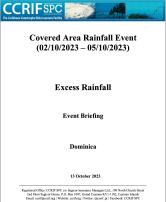 Event Briefing - Excess Rainfall - Covered Area Rainfall Event - Dominica - October 13, 2023
Event Briefing - Excess Rainfall - Covered Area Rainfall Event - Dominica - October 13, 2023 |
This event briefing describes the impact of rainfall on Dominica, which was associated with a Covered Area Rainfall Event (CARE) on October 2 to 5, 2023. The Rainfall Index Loss (RIL) for the Covered Area Rainfall Event was below the attachment point of the Excess Rainfall policy of Dominica, and therefore no payout is due to the Government of Dominica. |
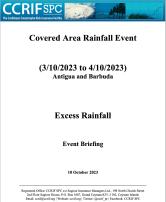 Event Briefing - Excess Rainfall - Covered Area Rainfall Event - Antigua and Barbuda - October 10, 2023
Event Briefing - Excess Rainfall - Covered Area Rainfall Event - Antigua and Barbuda - October 10, 2023 |
This event briefing describes the impact of rainfall in Antigua and Barbuda, which was associated with a Covered Area Rainfall Event (CARE), starting on 3 October and ending on 4 October 2023. |
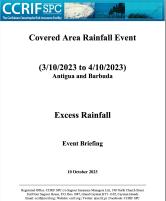 Event Briefing - Excess Rainfall - Covered Area Rainfall Event - Antigua and Barbuda - October 10, 2023
Event Briefing - Excess Rainfall - Covered Area Rainfall Event - Antigua and Barbuda - October 10, 2023 |
This event briefing describes the impact of rainfall in Antigua and Barbuda, which was associated with a Covered Area Rainfall Event (CARE), starting on 3 October and ending on 4 October 2023. |
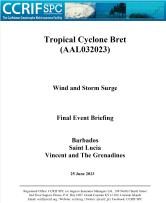 Final Event Briefing - TC Bret - Wind and Storm Surge - Barbados, Saint Lucia, St. Vincent and The Grenadines - June 25 2023
Final Event Briefing - TC Bret - Wind and Storm Surge - Barbados, Saint Lucia, St. Vincent and The Grenadines - June 25 2023 |
Tropical Storm Bret was the third named tropical cyclone of the 2023 Atlantic Hurricane Season. On 22 and 23 June, Bret passed over Barbados and the Windward Islands.Tropical-storm-force winds spread over Barbados, Saint Lucia and Saint Vincent and the Grenadines. At the time of writing this report, Bret was about to pass north of Aruba, Bonaire and Curacao, and was expected to dissipate within a few hours. |
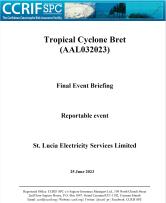 Final Event Briefing - TC Bret - Reportable Event - Saint Lucia Electricity Services Limited - June 25 2023
Final Event Briefing - TC Bret - Reportable Event - Saint Lucia Electricity Services Limited - June 25 2023 |
Tropical Storm Bret was the third named tropical cyclone of the 2023 Atlantic Hurricane Season. On 22 and 23 June, Bret passed over Barbados and the Windward Islands.Tropical-storm-force winds spread over Barbados, Saint Lucia and Saint Vincent and the Grenadines. At the time of writing this report, Bret was about to pass north of Aruba, Bonaire and Curacao, and was expected to dissipate in a few hours. |
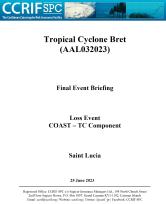 Final Event Briefing - TC Bret - Loss Event COAST - TC Component - Saint Lucia - June 25 2023
Final Event Briefing - TC Bret - Loss Event COAST - TC Component - Saint Lucia - June 25 2023 |
Tropical Storm Bret was the third named tropical cyclone of the 2023 Atlantic Hurricane Season. On 22 and 23 June, Bret passed over Barbados and the Windward Islands.Tropical-storm-force winds spread over Barbados, Saint Lucia and Saint Vincent and the Grenadines. At the time of writing this report, Bret was about to pass north of Aruba, Bonaire and Curacao, and was expected to dissipate in a few hours. |

